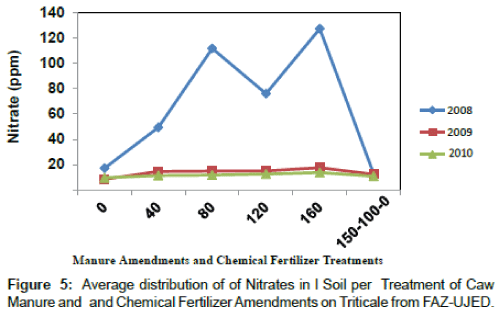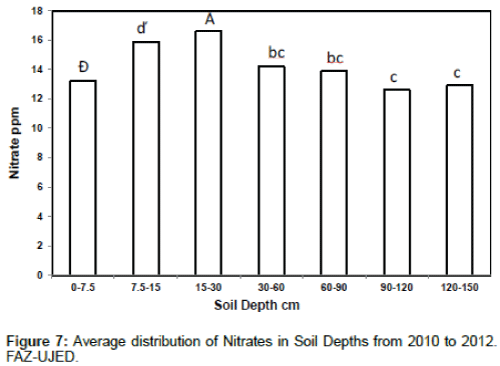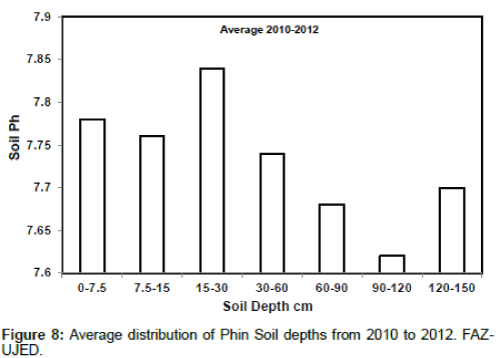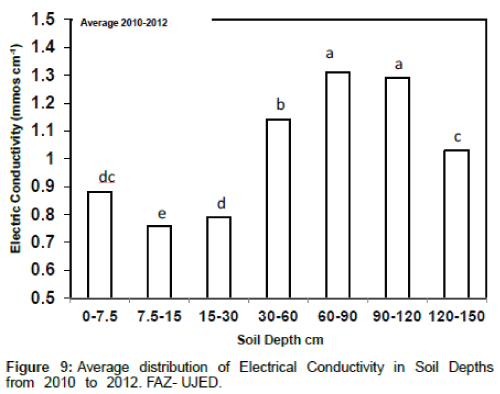Research Article Open Access
Long Term of Cattle Manure Amendments and Its Impact on Triticale (X. Triticosecale Wittmack) Production and Soil Quality
Enrique Salazar Sosa1, Hector I Trejo Escareno3*, Jesus Luna Anguiano2, Miguel A. Gallegos Robles3, Enrique Salazar Melendez2, Jose Dimas Lopez Martinez3 and Orona Castillo Ignacio3
1Technology Institute of Torreon, Mexico
2Agricultural Sciences and Forestry, Mexico
3College of Agriculture and Animal Husbandry of Durango University of Durango State (FAZ-UJED), Ejido Venecia Municipal of Gomez Palacio, Durango. Km 28 Gomez Palacio-Tlahualilo, Mexico
- Corresponding Author:
- Hector I. Trejo Escareno
College of Agriculture and
Animal Husbandry of Durango University of Durango State
(FAZ-UJED), Ejido Venecia Municipal of Gomez Palacio
Durango. Km 28 Gomez Palacio-Tlahualilo, Mexico
Tel: 5218712115284
E-mail: fazujed@yahoo.com.mx
Received March 09, 2016; Accepted April 13, 2016; Published April 19, 2016
Citation: Sosa ES, Escareno HIT, Anguiano JL, Robles MAG, Melendez ES, etal. (2016) Long Term of Cattle Manure Amendments and Its Impact on Triticale (X. Triticosecale Wittmack) Production and Soil Quality. Adv Crop Sci Tech 4:223. doi:10.4172/2329-8863.1000223
Copyright: © 2016 Sosa ES, et al. This is an open-access article distributed under the terms of the Creative Commons Attribution License, which permits unrestricted use, distribution, and reproduction in any medium, provided the original author and source are credited.
Visit for more related articles at Advances in Crop Science and Technology
Abstract
Organic amendment is a good alternative to improve soil fertility to maintain or increase crop forage and grain production. After several times of organic applications (crop cycles), it is important to follow soil physical and chemical parameters to avoid soil pollution such as salinity and nitrate. The main objective of this study was to maintain good triticale forage production and soil quality after seven years in plots where two factors were studied: cow manure amendments; 0, 40, 80, 120 and 160 t ha-1 and one chemical level with 150-100-00 kg ha-1 of Nitrogen, Phosphorus and potassium, respectively just to compare manure amendments. After this, to decrease soil salinity and high levels of nitrate, triticale forage was planted in the same plots using two varieties without manure and chemical fertilizer application. Triticale variables measured were green forage and ential (Ph) and Nitrates (NO3). Results indicated that triticale forage production was high in all plots were cow manure was applied after three years than the control and chemical fertilizer level, also, the chemical soil parameters such as, salinity and nitrate decrease to adequate levels of: 4 mmhos cm-1 in salinity and less than 20 ppm of nitrates. Triticale forage production was better in all plots with cow manure application with more than 25 mg ha-1, that’s the triticale average production in this region and more than 100% of the control and chemical fertilizer plots. According to these results, cow manure amendments is a good alternative to get high triticale forage production and maintain a good soil quality.
Keywords
Manure; Soil pollution; Nitrate; Production of the crop and salinity
Introduction
Mexico has a production of 61 million tons of manure considering only the feedlot cattle and partial barn, where the main basin of this important residue are the Laguna Region, the Juarez Valley and other estimated areas of northern and northeastern Chihuahua [1]. Dairy cattle manure and other organic fertilizers used in agriculture have the potential to be a cost-effective source of nutrients for crops. Land application determines an increase in fertility as well as improved physical properties [2].
The organic waste is accumulated in the places where this waste is generated or applied commonly to score some agricultural land, which can cause degradation of the quality of soil and groundwater [3]. The amount of manure nutrients available in the soil for plants, is perhaps one of the most common questions without exact answer because of the many physical, chemical and biological factors involved in the process of decomposition of organic materials [4]. One of the most precise ways is by evaluating the decomposition of manure in the field directly [5].
The use of this fertilizer is unquestionably beneficial, but there are difficulties to predict its effect in every situation due to the great variability of the material covered and the differences created by the previous management [6]. In this case a classification of the type of material is necessary to predict their nutrient to crops [7] this prediction is important because it may cause environmental pollution when applying excessive doses, either excessive loss from gas losses N (denitrification processes and ammonia volatilization loss as NO3 leaching [8,9].
Producers who use this fertilizer, use it indiscriminately applying a high dose of 200-250 tons per hectare per year, making it necessary to carry out an analysis of the salt balance and soil quality without forgetting that the key is to avoid inappropriate use of a resource to protect the quality of soil and water [10,11].
The fodder produced in the spring-summer cycle, is not enough to feed the livestock during the winter season, this caused the producers to look for alternatives to help them supplement the food supply, both in quantity and quality this season [12].
The Comarca Lagunera is the most important dairy region of Mexico and Latin America. A good alternative that has been used to replace alfalfa as a protein source is growing forage triticale [13]. This is a winter crop, which has been included in the diets of dairy cattle, since this crop brings a high potential for biomass production (10.59 mg ha-1 of dry matter), with adequate nutritional value (16.76% PC), it is also very tolerant to adverse environmental factors.
Materials and Methods
Geographic location.
The Laguna Region is located in the north-central part of the Mexican Republic [14]. This is between the meridians 102° and 104° 47’ 22’ west longitude and 24°22’ and parallel 26°23’ North latitude. The average height above sea level is 1,139 m. It consists of a hilly expanse and other flat where agricultural and urban areas, comprising an area of 4, 788, 750’ve-1 are located [11]. According to Koeppen classification modified by Cervantes. The climate is dry desert or warm steppe with summer rains and cool winters. The average annual temperature is 21°C, with an average annual evaporation of about 2,396 mm [15]. The rainfall is 258 mm [15]. In the region the predominant clay soils are heavy duty, medium sandy loam [15]. Soil type that was used is clay type, which interferes with ground mineralization as reported by Vazquez et al. [15]. This research was conducted in the experimental agricultural field of the Faculty of Agriculture and Animal Husbandry- UJED, which is located at km 28 of the Gomez Palacio-Tlahualilo, Durango road, to nearby Venice ejido, municipality of Gomez Palacio, Durango.
Soil characteristics and manure
Three random samples of soil and manure were collected to be analyzed at the laboratory of FAZ- UJED [14], to determine the conditions in which the soil and manure were before the establishment of the experiment.
Establishment of experiment
The experiment was conducted in the fall-winter cycle of the years 2008, 2009 and 2010, after planting corn every year since 1978. Initially, since this year the experiment was established with doses of bovine manure of 0, 40, 80, 120 and 160 Mg ha-1 with characteristics shown in Table 1 and further treatment with chemical fertilizer 150-150-0 kg ha-1 of nitrogen, phosphorus and potassium, respectively. These treatments were distributed in field under a randomized block design arrangement in strips, where each group contained three replicates in an experimental unit of eight meters wide by eight meters long with. Statistical analysis was performed with the Statistical Analysis System software package Ver. 9.
| Soil depth cm | PH | C.E. dS m-1 |
M.O.% | No3 mg kg-1 |
P mg kg-1 |
K mg kg-1 |
N-NH4 |
|---|---|---|---|---|---|---|---|
| 0-15 | 8.14 | 1.36 | 1.93 | 14 | 7.5 | 1360.0 | 9.8 |
| 15-30 | 8.25 | 1.33 | 1.58 | 7 | 6.5 | 892.5 | 12.95 |
| 30-60 | 8.20 | 1.20 | 1.24 | 3 | 11.0 | 572.5 | 13.65 |
| 60-90 | 8.24 | 3.16 | 0.89 | 4 | 3.5 | 410.0 | 14.35 |
| 90-120 | 8.14 | 3.93 | 0.27 | 2 | 3.5 | 202.5 | 12.95 |
Table 1: Soil Chemical Characteristics Before the caw manure Application. C.A.E.-FAZ-UJED 1998.
After 2004 manure doses were reduced by 50% because it was detected through the soil analysis that the salinity levels increased higher than 4 cm mmhos cm-1 (Table 2). This action was not enough to reduce the salinity to permissible values lower than the 4 mmhos cm-1, so it was decided to plant a crop with total coverage of soil surface and to consume the maximum amount of salts with good yields and high quality of forage mainly with protein content similar to alfalfa but, with less water consumption to make it attractive crop forage for the dairy protein producer in the region. The triticale forage crop is an excellent fodder for milk production livestock in this region, where there are more than 500,000 heads of cattle for this purpose making it the most important dairy region of Latin America. Triticale sowing was carried out since 2008 after planting corn in the summer season, but with absolutely no manure applied in each plot, where the organic fertilizer was applied since 1978. This is how the way to not only have a high protein forage and performance, but also have a forage crop that absorbs as much salts and improves soil quality as well as to take advantage of all the residual nitrogen accumulated in it was sought.
| Sample number | Prof.cm | % N total | PX | K % | Ca % | Na % | Mn ppm | Fe ppm | Zn ppm | Cu ppm | Bp ppm |
|---|---|---|---|---|---|---|---|---|---|---|---|
| 1 | 0-15 | 1.51 | 0.356 | 3.27 | 3.38 | 0.97 | 560 | 10960 | 200 | 49 | 390 |
| 2 | 15-30 | 1.39 | 0.388 | 3.32 | 3.47 | 1.02 | 620 | 12300 | 198 | 45 | 450 |
| 3 | 30-45 | 1.3 | 0.344 | 3.4 | 3.41 | 1.07 | 600 | 11250 | 206 | 53 | 410 |
| 4 | 45-60 | 1.27 | 0.358 | 3.3 | 3.31 | 0.98 | 590 | 11200 | 198 | 47 | 400 |
Table 2: Manure Chemical Characteristics C.A.E.-FAZ-UJED 1998.
Harvest
Harvesting took place 110 days after planting, when the crop was in boot stage and about 10% flowering, this was at 1 m2 per experimental unit to determine its performance. The variables evaluated in the soil were: organic matter (OM) with Walkley and Black method [16], Electrical Conductivity extract with resistivity, pH with pH meter extract, and nitrates (NO3) with colorimetric [16]. The variables evaluated on the ground allowed us to determine what the best treatments were. Forage yield and plant height also were measured to evaluate treatments of manure applied.
Results and Discussion
Production of green forage
The production of green forage was statistical different for treatments of manure in the three years of evaluation (Table 3 and Figure 1), with higher production in the treatment of 40 Mg ha-1 with 55.2% more than in the control for the year 2008. This results being statistically equal with each other treatment, except the control which obtained lower production. In 2009 29.7% more forage yield was obtained in the treatment of 20 Mg ha-1 of bovine manure applied and resulting statistically equal to 40, 80 Mg ha-1 and the chemical fertilizer treatment. In 2010 the output was 74.3% more in the treatment of 60 Mg ha-1 of bovinemanurewhich showed statistically equal to treatment of 20 Mg ha-1 of bovine manure. Also, the treatments of 40 and 80 Mg ha-1 of manure applied were statistically equal with 57.86% from the control which showed a lower yield, chemical fertilizer was higher than the control but less than all cattle manure treatments reaching 36.8% more yield forage compared with the control. These results clearly indicated that the manure increased forage yields after several times that was applied in the soil, for this reason it is a good alternative for farmers to save money in chemical fertilizer and to get good yields in this region, similar results were found by Salazar et al. [17-19].
| Contents | FD | Years | ||
|---|---|---|---|---|
| 2008 | 2009 | 2010 | ||
| R(Replications) | 2 | ----------------------------Pv>F-------------------------------- | ||
| 0.0076 | 0.1415 | 0.5951 | ||
| FA(Triticale Varieties) | 1 | 0.0698 | 0.0864 | 0.1100 |
| FB (Manure Levels) | 5 | 0.0480** | 0.0512* | 0.0007* |
| DMS(Manure Levels) | 9.65 | 4.95 | 15.45 | |
**Statistically significant at the 5 % and *Statistically highly significant at 1%
Table 3: Means for corn yield per year of study.
Soil and manure characteristics
Table 1 shows the soil test before starting the original experiment in 1998. It shows that the ground has normal characteristics of the soils in the region with a low content of organic matter (OM), alkaline pH and low salt Electric Conductivity (EC) less than 4 mmhos cm-1 and very low levels of nitrate (NO3), ammonium (NH4), phosphorus (P2O5), potassium (K+), that had very low fertility to 120 cm depth. Regarding the manure (Table 1 and 2) and after analyzing its features in a pile of accumulation at different depths up to 50 cm, a total range of nitrogen was found from 1.27 to 1.51 with wide variations in other nutrients as; P2O5, K+, Ca2+, Mg2+, Na+, Mn2+, Fe2+, Zn2+, Cu+ and Bo; which allows for a quantitative support to calculate the quantity of nutriment applied when different amounts are added to the soil. This does not mean that these values when multiplied by the dry residue of the plant gives the amount of nutrient available to it, because other nitrogen transformation must be considered such as mineralization, also how much is immobilized, or volatilized and leached so extensive care should be taken to determine the amount of nutrient available for biodegradation of manure after application in soil.
Table 4 shows the chemical characteristics of the soil after application of manure for 9 years in the different treatments of manure at two depths: 0 cm -15 cm and 15 cm - 30 cm, where increased EC, MO, NO3, K+, Ca2+ and Na were observed mainly in treatments from 40 to 160 t ha-1 of manure applied. The average EC levels were higher than four mmhos cm-1 permissible in a farm field and the contents of OM with more than 5% macronutrientlevels over 150 PPM and so with other micronutrients prompting that doses to decline in the following years to 50%. Not finding an acceptable decrease in the concentration of these parameters on the floor it was decided to plant in winter triticale with complete, high soil extraction but without applying manure for three years after planting corn in summer.
| Manure Treatments | Ph | CE mm cm-1 |
OM % |
NO3 Mg l-1 |
K+ Mg l-1 |
Ca++ Mg l-1 |
Na+ Mg l-1 |
|||||||
|---|---|---|---|---|---|---|---|---|---|---|---|---|---|---|
| * | ** | * | ** | * | ** | * | ** | * | ** | * | ** | * | ** | |
| 0 t ha l-1 | 7.32 | 7.40 | 1.91 | 1.47 | 1.35 | 1.21 | 18 | 17 | 14 | 115 | 9.2 | 8.0 | 13.2 | 6.5 |
| 40 t ha l-1 | 7.11 | 7.23 | 3.77 | 3.08 | 1.44 | 1.72 | 89 | 76 | 14.7 | 33 | 23.2 | 16.2 | 17.2 | 14.4 |
| 60 t ha l-1 | 6.93 | 7.14 | 6.20 | 3.26 | 5.52 | 2.07 | 136 | 87 | 15.4 | 11.3 | 32.2 | 14.5 | 35.4 | 15.5 |
| 120 t ha l-1 | 6.99 | 6.99 | 6.22 | 6.42 | 5.52 | 5.92 | 70 | 83 | 97 | 15.4 | 39.4 | 27.6 | 36.4 | 35.9 |
| 160 t ha l-1 | 6.8 | 6.92 | 6.28 | 5.2 | 6.62 | 2.42 | 168 | 102 | 17.8 | 20.3 | 22.4 | 15.6 | 32.5 | 22.9 |
| 150-100-0 | 6.24 | 6.42 | 1.74 | 1.62 | 1.93 | 1.51 | 3 | 21 | 15 | 1.6 | 11.6 | 10.4 | 17.2 | 8.6 |
*Soil depth 0 cm-15 cm; **Soil depth 15 cm-30 cm
Table 4: Soil Chemical Characteristics After the cow manure Application. C.A.E.-FAZ-UJED 2007.
Figures 2, 3, 4 and 5 show the average concentration of pH, OM, NO3 and CE for the treatment of manure after planting triticale because with these parameters where found high and very variable concentrations in years prior to 2010. They can be seen as the OM, CE and NO3 decreased to acceptable levels considerably lower than the 4 mmhos cm-1 in EC demonstrating that culturing with full coverage and decreased the dose applied to the soil manure allowed preserve the quality of soil and maintain acceptable fertility to plant any crop.
Additionally and for detecting the concentration especially OM, CE and nitrates throughout the soil profile up to 1.50 cm deep, Figures 6, 7, 8 and 9 show these observed results. As the EC and Nitrates are highly soluble show high concentrations after the 30 cm depth, away from the area of maximum absorption due to the high concentrations found in the first 30 cm in the first 9 years of the experiment which, consequently, ample care should have especially nitrates, as these to be found in high concentrations after the first 30 cm because they are a potential contamination of the underground aquifer in this and other regions [20].
Discussion
According to the results found, cow manure amendments are important to improve soil crop forage production. However, special care is necessary to maintain good soil quality with respect to salinity and high concentration of nitrates. Triticale forage crops with all soil surfers cover is a good option to take up high concentration of salt and nitrate after several years. In this study, three years after seven applications of cow manure consequently, the soil salinity and nitrate were decreased to lower levels than the maximum permissible of 4 mmhos cm-1 in salinity and less than 20 ppm of nitrates. Triticale forage yields also were higher than 100% in all plots were caw manure was applied than the control and chemical fertilizer treatments. That means that soil must be monitored over time when organic amendments are used to avoid soil pollution due to high mineralization of
organic amendment that induce to more salinity and nitrate concentration in soil mainly. Additionally, soil nitrate and organic matter were higher in the first centimeters of depth (15) due to more mineralization than in the others soil depths decreasing at 150 cm. And because high concentrations of the solubility of nitrate and salt after 30 centimeters were found, soil monitoring of these parameters are important to avoid possible aquifer pollution in the future. Finally, caw manure amendments is a good option for farmers of this and other regions to improve soil quality and crop forage production.
References
- Cortes JJM (2007) Residual use of manure on wheat in the Yaqui Valley of Sonora. 19th international week of face-UJED agronomy November, pp: 209.
- Alexander M (1978) Introduction to soil microbiology. Soil science 125: 331.
- Allison FE (1995) The enigma of soil nitrogen of soil nitrogen balance sbeets. Advances in agronomy 7: 213-250.
- Lozano RA (2002) The magazine Marsh producer. Agricultural Laguna. Bimonthly publication of the Agricultural Cooperative Society of the Laguna Region, SCL.
- Flores JP, Flores RM, Palomo MB, Corral D (2003) Evaluation of biosolids with feed crops in the Valley of Juarez, Chihuahua. Validation project. INIFAP, Campo Experimental Valle de Juarez, Municipal Water and Sanitation Board of Cd. Juarez, Chihuahua Produce Foundation. Final Project Report.
- Jimenez LM, Larreal N (2004) walnut effects of bovine manure on chemical properties of degraded ultisol marchites area, colon state of Zulia. Journal of the Faculty of Agronomy University of Zulia 21.
- Cadahia CF (1998) Horticultural and ornamental crops: 2nd Edition, Spain, Eng, pp: 46-47.
- Aguirre LO (1987) Climate Guide to Laguna Region-SARHCIAN-INIA. Matamoros, Coahuila, Mexico, pp:174.
- Infoagro (2002) organic Fertilization.
- Powers WL, Wallingford GW, Murphy LS, Whitney DA, Manguez HL, et al. (1974) Guidelines for Applying beef feedlot manure to fields. Publication C-502.Kansas State University, Cooperative Extension Service. Manhattan, KA.
- Márguez FJP (2003) Management and biodegradation of biosolids applied to agriculture. In: Payne WJ (1973). Reduction of nitrogenous oxides by microorganisms. Bacteriul Rev 37: 409- 452.
- Rowell DM, Prescott CE, Preston CM (2001) Decomposition and nitrogen mineralization from biosolids and other organic materials: With initial relationship chemistry. J Environ Qual 30: 1401-1410.
- Vazquez VC, Salazar SE, Leos RJA, Fortis HM, Zuniga TR, et al. (2007) Impact of the application of cattle manure on soil quality and production of tomato (Lycopersicon esculentum Mill) organic fertilizers, pp: 63-64.
- SAGARPA (2002) Statistical Year book of Agricultural Production. SAGARPA. Laguna Region, Lerdo de Tejada, Durango, Mexico.
- Vazquez VC, Salazar SE, Figueroa VR, Fortis HM (2001) Effect of padding and cattle manure in modifying some soil characteristics of the Laguna Region.13th International Week of Agriculture, FAZ-UJED. Gomez Palacio, Durango, pp: 178-182.
- Paul EA (1989) Soil Microbiology and Biochemistry. In: Ed Academic Press, San Diego, California, pp: 115-130.
- Salazar SE, Leos RJA, Fortis HM, Vazquez VC (2002) HM Recovery and Nitrogen uptake by wheat and sorghum in stubble and no-tillage system. Agrociencia 36: 433-440.
- Salazar SE, Vazquez VC, Leos RJ, Fortis HM, Montemayor TJ (2003) Mineralization cattle manure and its impact on soil quality and production of tomato (Lycopersiconesculentum Mill) under subsurface irrigation, journal of Python.
- Salazar SE, Vazquez VC, Rivera O (2002) Management and biodegradation of bovine manure in the Laguna Region, Proceedings of the 15th International Week of Agriculture, Faculty of Agriculture and Animal Husbandry of the Juarez University of Durango State.
- Salazar SE, Vazquez VC, EI Trejo (2002) El of organic fertilizers and plasticultura, UJED-SMCS nitrogen cycle.
Relevant Topics
- Agricultural science
- Agronomy
- Climate impact on crops
- Crop Productivity
- Crop Sciences
- Crop Technology
- Field Crops Research
- Hybrid Seed Technology
- Irrigation Technology
- Organic Cover Crops
- Organic Crops
- Pest Management
- Plant Genetics
- Plant Breeding
- Plant Nutrition
- Seed Production
- Seed Science and Technology
- Soil Fertility
- Weed Control
Recommended Journals
Article Tools
Article Usage
- Total views: 11579
- [From(publication date):
June-2016 - Aug 28, 2025] - Breakdown by view type
- HTML page views : 10582
- PDF downloads : 997









